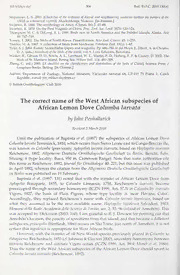
The Correct Name of the West African Subspecies of African Lemon Dove Columba Larvata PDF
Preview The Correct Name of the West African Subspecies of African Lemon Dove Columba Larvata
JinMlfkovsky 304 Bull. B.O.C. 2010 130(4) Stepanyan, L. S. 2003. [Check-list ofthe avifauna ofRussia and neighbouring countries {within the borders ofthe USSRasahistorical region)].Akademkniga,Moscow. [InRussian.] Swirthoe,R. 1860. TheornithologyofAmoy(China).Ibis2:45-68. Swinhoe,R. 1870. OnthePiedWagtailsofChina. Proc. Zool. Soc. Lond. 1870: 120-124. Thompson, M. C. & DeLong, R. L. 1969. Birds new to NorthAmerica and the PribilofIslands, Alaska. Auk 86: 747-749. Tomek,T. 2002. ThebirdsofNorthKorea.Passeriformes.ActaZool. Cracov.45: 1-235. Traylor,M. A. 1967.AcollectionofbirdsfromSzechwan.FieldianaZool. 53(1): 1-67. Tyler,S.J.2004.FamilyMotacillidae (pipits andwagtails). Pp. 686-786in delHoyo,J.,Elliott,A. &Christie, D.A. (eds.)Handbookofthebirdsoftheworld,vol. 9. LynxEdicions,Barcelona. Winker,K.,Gibson,D. D.,Sowls,A.L.,Lawhead,W. E.,Martin,P.D.,Hoberg,E.P. &Causey,D.2002. The birdsofSt.MatthewIsland,BeringSea. Wilson Bull. 114.491-509. Zheng, G. (ed.) 2005. [A checklist on the classification and distribution ofthe birds ofChina]. Science Press / LongmenBooks,Beijing. [InChinese.] Address: Department of Zoology, National Museum, Vaclavske namesti 68, CZ-115 79 Praha 1, Czech Republic,e-mail:[email protected] ©BritishOrnithologists' Club2010 The correct name of the West African subspecies of African Lemon Dove Columba larvata by John Penhallurick Received3March 2010 Until the publication of Baptista et al. (1997) the subspecies of African Lemon Dove Columba larvata Temminck, 1810,whichoccursfromSierraLeoneeasttoCongo-Brazzaville, was known as Columba (previously Aplopelia) larvata inornata, based on Haplopelia inornata Reichenow, 1892, Allgemeine Deutsche Ornithologische Gesellschaft zu Berlin, Bericht, Febr. Sitzung: 6 (type locality: Buea, 950 m, Cameroon Range). Note that some authorities cite this name as Reichenow, 1892, Journal fur Omithologie 40: 221, but this issue was published in April 1892, whereas the citation from the Allgemeine Deutsche Ornithologische Gesellschaft zu Berlin was published on 19 February. Baptista et al. (1997: 131) noted that with the transfer of African Lemon Dove from Aplopelia Bonaparte, 1855, to Columba Linnaeus, 1758, Reichenow's inornata became preoccupied through secondary homonymy (ICZN 1999, Art. 57.3) in Columba by inornata Vigors, 1827, the basis of Plain Pigeon, whose type locality is 'near Havana, Cuba'. Accordingly, they replaced Reichenow's name with Columba larvata hypoleuca, based on what they assumed to be the next available name: Haplopelia hypoleuca Salvadori, 1903, Memorie delta Reale Accademia delle Scienze di Torino, ser. 2, 53: 96 (island of Annobon). This was accepted by Dickinson (2003: 160). I am grateful to R. J. Dowsett for pointing out that Annobon's location, the paucity ofspecimens from that island, and that because a different subspecies, principalis (Hartlaub, 1866) occurs on Sao Tome, just north of Annobon, it is not certain that hypoleuca is appropriate for West Africanbirds. However, with the transfer of all New World species previously placed in Columba to Patagioenas Reichenbach, 1853 (cf. Johnson & Clayton 2000), secondary homonymy between inornata Reichenow and inornata Vigors ceases (ICZN 1999, Art. 59.4; Morel ct al. 1986). Thus the name of the West African subspecies of the African Lemon Dove should revert to Columba larvata inornata (Reichenow, 1892). EdwardC. Dickinson 305 Bull. B.O.C. 2010 130(4) Acknowledgements ThankstoBobDowsett,AlanPetersonandDickSchoddefortheircomments. References: Baptista, L. Fv Trail, P. W. & Horblit, H. M. 1997. Family Columbidae (pigeons and doves). Pp. 60-245 in del Hoyo, J., Elliott, A. & Sargatal, J. (eds.) Handbookofthe birds ofthe world, vol. 4. Lynx Edicions, Barcelona. Dickinson, E. C. (ed.) 2003. The Howard and Moore complete checklist of the birds of the world. Third edn. ChristopherHelm,London. International Commission on Zoological Nomenclature (ICZN). 1999. International code of zoological nomenclature. Fourth edn. International Trust for Zoological Nomenclature, c/o The Natural History Museum,London. Johnson, K. P. &Clayton, D. H. 2000. Nuclearand mitochondrial genes containsimilarphylogenetic signal forpigeonsanddoves (Aves:Columbiformes).Mol. Phyl. &Evol. 14: 141-151. Morel,G.J.,Morel,M.Y.&Fry,C.H. 1986.Columbidae,pigeonsanddoves.Pp.U2-A97inUrban,E.K.,Fry, C. H. &Keith,S. (eds.) ThebirdsofAfrica,vol.2. AcademicPress,London. Address: 86BingleyCrescent,Fraser,A.C.T.,Australia,e-mail:[email protected] ©BritishOrnithologists'Club2010 The authorship of the name Lophornis Verreauxii; that of a subspecies of Festive Coquette by Edward C. Dickinson Received31 March 2010 There has been justifiable confusion regarding the authorship of the name of this hummingbird. Describedonp. 193ofthe 1853RevueetMagasin deZoologie(hereafterRevue), the name appeared as Lophornis Verreauxii, Bourc, par MM. Jules et Ed. Verreaux. Peters (1945: 32) ascribed the name to 'Bourcier and E. Verreaux'. Zimmer (1950: 17) ascribed the nameto ]. andE. Verreaux'. Zimmerwrote: 'Thepapercomprisingtheoriginaldescription was undoubtedly written by Jules and Edouard Verreaux, although they cite Bourcier as authority for the name, probably from the label of the type. They appear as authors of the paperalsointhelistofcontentsattheend ofthenumberoftheRevueinwhichitappeared, but in the index to the entire volume Bourcier is given as the author of the paper and the name. In Mulsant and Verreaux's "Histoire naturelle des oiseaux-mouches" (vol. 3, p. 221) Boucier is cited as authority for the name, but on page 229, in a bibliography ofpapers by J. and E. Verreaux, the title ofthe original article againappears. Although there isno doubt that Bourcier planned to honor Edouard Verreaux by naming this bird for him, I see no way he can be credited even as part author since he had no connection with the original publication.' Zimmer's attributionwas understandably retained byZiichner (1999: 568). Zimmer was a remarkably accurate bibliographer; he may have missed the vital evidence which explains why the index to that volume of the Revue listed Bourcier as the author, or he may havejudged that the rules ofnomenclature then in use did not demand acceptanceofBourcier. ThenewnameappearedintheMayissue. IntheJuneissuethefinal page,p. 288,includedtwoerrataandbelowthemthefollowingnote: 'MM.JetEd.Verreaux nous demandent de rectifier une erreur qui a ete commise en imprimant leurs noms a la suitedecelui deM. Bourcier. C'estaM. Bourcierseulqu'estdueladescriptionduLophornis Verrauxii, page 193, pi. 6'.
